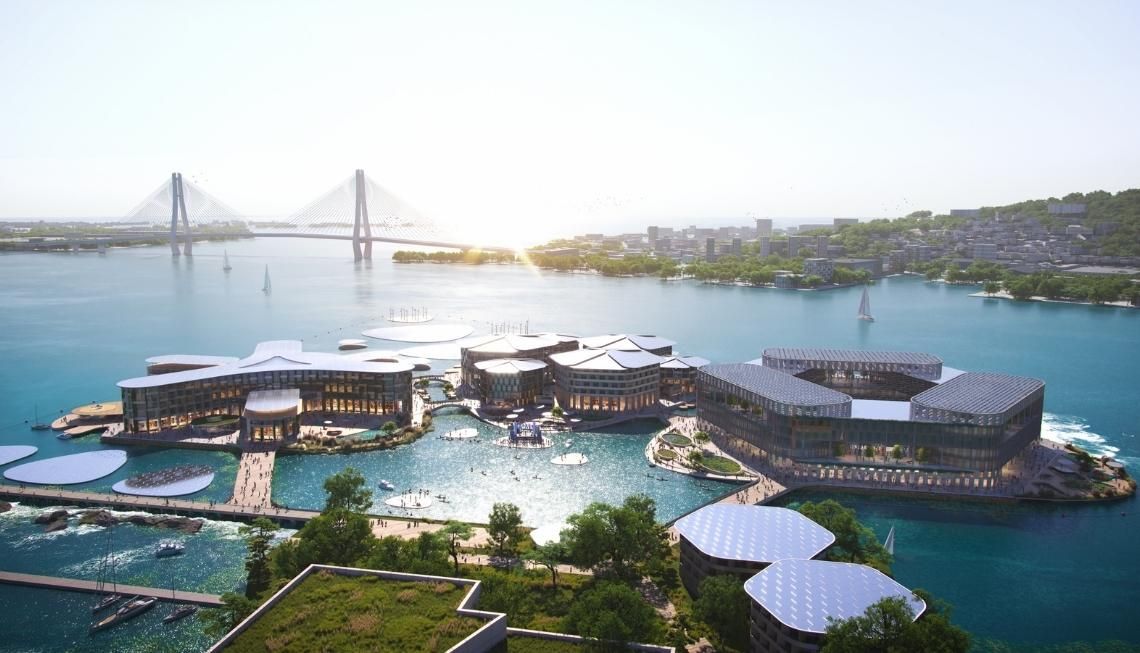Inside the world’s first climate resilient floating city in South Korea
By Ming En Liew
In the face of rising sea levels, what will cities of the future look like? Experts working on the world’s first prototype floating city share why they might be the future.

But one South Korean city is hoping to turn the tides with the world’s first floating city. This city will be built off the coast of Busan, a port city which has borne the brunt of rising sea levels and increased rainfall over the years.
The people behind the floating city – from the Busan Metropolitan City and blue tech firm OCEANIX – give a glimpse of what it will look like, and why it is the future.
Cities that float instead of sink
Rising sea levels are a reality that coastal cities around the world need to prepare for, says Itai Madamombe, Co-founder, OCEANIX. In Busan, for example, the Centum City area is at risk of being submerged as early as 2030, reveals Park Jaesung, Team Leader of the floating city.
This is because climate change has led to increased rainfall in the area and made Busan’s roads less water-resistant. As a result, Busan experiences “increased damage from flooding”, Park explains.

Floating cities are climate resilient as they cannot flood.
Floating cities provide a viable solution to these challenges, as they “cannot flood’, says Madamombe. These cities are anchored onto the seabed with flexible anchors. When the water rises, the city will rise with it.
Their benefits are manifold. They create new land for coastal cities facing land shortages, provide them with a sustainable way to expand, and help them adapt to rising sea levels, she shares.
A self-sustaining city
OCEANIX and Busan are hoping that this floating city will eventually be completely self-reliant in areas like water, energy and food, says Itai. “Nothing that we put into the city goes out into the water,” shares Madamombe.
For example, any wastewater that citizens generate will be recycled and repurposed for use in different functions such as agriculture. The floating city will adopt technologies already being used in other marine industries like cruise lines to achieve this, says Matteo Pietrobelli, Chief of Design and Engineering at OCEANIX.
Besides water, Busan and OCEANIX are also looking into different sources of renewable energy. The team is considering solar power, waves, wind, and algae, Pietrobelli shares.
Meanwhile, 3D vertical farms will help generate food for the city. This farming method creates an underwater garden with floating long lines, shares Pietrobelli. The lines support vertical crops and food farming such as mussels, scallops, oysters, seaweed, and clams.
It may not be possible to start out 100 per cent self-reliant, shares Madamombe. But the aim is to continue iterating so that they are completely sustainable.
Revolutionising city building

The Busan Floating City is built with individual platforms, that can scale over time.
Floating cities are highly configurable, Madamombe shares. Unlike building on land, floating cities are made up of floating platforms that are anchored to the seabed. This means that different platforms in the city can be unplugged and moved if necessary, she explains.
“If it got down to it and there was a disaster in that area, you can unplug the whole city and move it elsewhere,” says Madamombe. “This reduces a lot of material use because you don’t need to demolish everything.”
Additionally, building a city from scratch means that “we can bring our best thinking to the process,” Madamombe notes. “Right now, with existing cities, you’re trying to retrofit to address mistakes that have already been made,” she says.
But by building something completely new, governments have the opportunity to develop new ways of living on the ocean and to solve problems before they even happen, she shares.
How floating cities help marine life
Floating cities are also a much more sustainable alternative to the land shortage faced by many sinking coastal cities.
Many cities turn to land reclamation as a means to increase their land area. But the process destroys the ocean at two points – where sand is obtained, and where it is dumped. The process kills everything that existed there before, Madamombe says. Floating cities, on the other hand, can co-exist in harmony with life below water.
Busan’s floating city will do so by regenerating marine ecosystems using biotechnology, says Park. OCEANIX plans to use biorock in the construction process, which can help to grow new coral reefs.

Beneath the water, biorock and 3D farming help with habitat regeneration and cleaning the sea water.
Biorocks create artificial reefs where corals can thrive, explains Pietrobelli. “Corals are known for attracting a diverse ecosystem, which is the foundation of habitat regeneration,” he adds.
Another way that this floating city will help marine life is through 3D ocean farming. “The beauty is that in this farming we need zero inputs to grow the crops, which means, no nutrients, no fertiliser, no freshwater,” he shares.
Such crops also keep the oceans clean and reduce carbon. For instance, oysters can filter up to 50 gallons of water a day. Meanwhile, kelp can absorb up to five times more carbon than land-based plants, adds Pietrobelli. This is vital as carbon dioxide is one of the main contributors to global warming, since it traps heat.
As cities today continue to struggle against floods and rising sea levels, this prototype floating city may well be the blueprint for cities of the future. With construction set to begin in 2023, all eyes will be fixed on Busan’s coast in anticipation of the new horizons the city will bring.
All photos courtesy of OCEANIX/BIG-Bjarke Ingels Group.